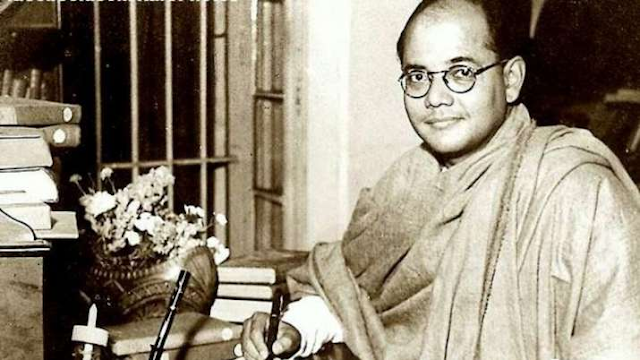In April 1956, the government of India, in response to the public demand, appointed an inquiry committee consisting of Sarvashri Shah Nawaz Khan, Suresh Chandra Bose (elder brother of Netaji Subhas Chandra Bose) and S. N. Maitra, formerly chief commissioner of Andaman and Nicobar, to ascertain the circumstances concerning Netaji's alleged death in an air crash.
Two members of the committee (Shah Nawaz and S. N. Maitra) came to the conclusion that Netaji indeed died in an air crash at Taihoku on 18th August 1945, while Suresh Chandra Bose did not agree with this report and submitted dissenting report. The Majority report was accepted by the government.
The controversy over the disappearance of Netaji was, however not resolved and demands continued to be made for undertaking another inquiry into the matter because of the rumors of his subsequent appearance elsewhere. In response to the demands of fresh inquiry, in July 1970 G. D. Khosla, retired chief justice of Punjab High court was appointed as a one-man commission to look into the matter. The commission visited Japan, Burma, Thailand, Singapore, Malaysia, South Vietnam, and Formosa(Taiwan) and examined 224 witnesses including 100 who were examined abroad. A large number of files and documents were produced and cited in evidence, The commission submitted its report on the 30th of June 1974. The commission arrived at the same conclusion reached by the Shah Nawaz Khan Committee in 1956 that Netaji died in an air crash at Taihoku on 18th August 1945.
The main conclusion reached by the commission in its inquiry is as follows:
On the morning of 16 August 1945, Netaji left Singapore accompanied by a few colleagues and others and arrived at Bangkok at 3.30 P.M. and spent the night there, at about 8 am on 17, Netaji left by two planes and reached Saigon at 11 am.
The Commission examined, among others, 8 witnesses who accompanied Netaji in his journey up to Saigon. These include
- Hachia who was deputed by the Japanese Government to assist Netaji as Minister of the Provisional Government of free India. He remained with Netaji till August 17,
- Nigeshi, another official of the Japanese Government who delivered the letter containing the terms of surrender to Netaji at Saramban, accompanied him to Singapore and remained with him till the morning of 17 August
- and a General, who was the Chief of the Hikari Kikan, Liaison agency of the Japanese Government with the Azad Hind Government. He Joined Netaji in Singapore and went with him up to Saigon.
- The others were S. A. Iyer, Gulzara Singh, and Ahid Hasan who were members of Netaji's Provisional Government besides Debnath Das and Col. Pritam Singh who were close confidants of Netaji.
The next day, the bomber left Tourain and arrived at Taipei in Formosa at 2 pm. At Taipei, the pilot attended to a snag in one of the engines which he declared had been corrected after a short while. The passengers accordingly boarded the flight and the pilot took off at 2.35 pm. Within a few seconds, one of the engines flew out and the plane crashed near the fringe of the Taihoku airfield. The body of the plane broke into two parts and caught fire. Netaji had sustained burn injuries of the third degree in the air crash. He was rushed to the Military Hospital where, despite the efforts of the doctors to revive him, he succumbed to the injuries the same night.
The commission examined, among others, four witnesses who claimed to have traveled in the ill-fated bomber plane with Netaji on 18 August, including the Navigator of the plane. The testimony of these 4 eyewitnesses was corroborated by all other witnesses before the commission. Among the corroborating witnesses was Dr. Yashimi who was acting as the chief of the Branch hospital at Taihoku Army Hospital, who claimed to have been present when Netaji died and to have signed his death certificate.
The Commission concluded that the numerous stories about the meetings of other people with Netaji at various places and times after 1945 are completely false and unacceptable. The Commission has thus arrived at the same conclusion reached by the Shah Nawaz Khan, that Netaji died in the airplane crash"
It looks clear from these reports that Netaji really died in the air crash, but wait, this is not the complete picture, because if it were so then there would have been no need for the appointment of a third Commission i.e. Mukherjee Commission to look into the matter and in fact, his report was the complete opposite of previous two.
Mr. Suresh Chandra Bose, one of the members of the inquiry Commission, and many others opposed Shah Nawaz's credentials for being the head of the Commission as he was against the Netaji and loyal to the Britishers (according to the book 'Red-Fort trial'), so his report was not trusted by all, in fact, Mr. Suresh Chandra Bose prepared a separate dissentient report, concluding that there was no airplane crash and consequently no death of Netaji from it.
In his report, he cited many incidences as to how witnesses and evidence were manipulated and how Shah Nawaz was working to prove his firm belief of Netaji's death in a plane crash. On the other hand, Samar Guha, an Indian independence movement activist and close associate of Bose raised various points, regarding the discrepancies in the Khosla Commission report, in his speech in the Lok Sabha on August 3, 1977. The next post will be dedicated to the discrepancies in the Shah Nawaz Commission report and why it was not accepted by all except the government.

